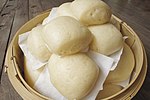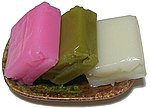Look up 餅 in Wiktionary, the free dictionary. 餅 may refer to: Bing (Chinese flatbread), dough-based Chinese flatbreads, pancakes, and other unleavened...
366 bytes (89 words) - 22:54, 29 March 2016
dessert is known as mizu shingen mochi (水信玄餅). The dish is an evolution of the Japanese dessert shingen mochi (信玄餅). Shingen mochi was developed in the 1960s...
8 KB (807 words) - 11:35, 25 October 2024
List of pastries "全安堂台灣太陽餅博物館 - 首頁". www.sunnycake.tw. Ricky, Hsu. "台中名產,太陽餅,太陽堂老店,台中太陽餅,創始店,太陽餅老店25號,太陽堂太陽餅純手工製作,太陽餅DIY,太陽餅文物館─純手工打造,台中市自由路二段 25 號"....
3 KB (274 words) - 08:33, 28 December 2024
Haw flakes (redirect from 山楂餅)
Haw flakes (Chinese: 山楂餠; pinyin: shānzhā bǐng) are Chinese sweets made from the fruit of the Chinese hawthorn. The pale/dark pink candy is usually formed...
4 KB (346 words) - 22:32, 28 July 2024
Warabimochi (蕨餅, warabi-mochi) is a wagashi (Japanese confection) made from warabiko (bracken starch) and covered or dipped in kinako (sweet toasted soybean...
6 KB (565 words) - 12:18, 14 September 2024
Zunda-mochi (ずんだ餅) is a type of Japanese confectionery popular in northeastern Japan. It is sometimes translated as "green soybean rice cake." It generally...
9 KB (885 words) - 16:15, 23 May 2024
普及,繼而傳到南方。中國古代的麵食品種,通稱為"餅"。據《名義考》,古代凡以麥麵為食,皆謂之"餅"。以火炕,稱"爐餅",即今之"燒餅",以水淪,稱"湯餅"(或煮餅),即今之切面、麵條:蒸而食者,稱"蒸餅"(或籠餅),即今之饅頭、包子:繩而食者,稱"環餅"(或寒具),即今之饊子。。" Andrew Coe...
20 KB (2,338 words) - 01:15, 2 January 2025
When using garlic chives (jiucai), these pancakes are called jiucai bing (韭菜餅) or jiucai you bing (韭菜油餅). In Cambodia, cong you bing is known as num pang...
5 KB (374 words) - 04:15, 17 December 2024
called Habutai mochi (腹太餅) (belly thick rice cake) because of its filling's nature. Later, the name was changed to daifuku mochi (大腹餅) (big belly rice cake)...
5 KB (487 words) - 07:27, 29 November 2024
Hujiao bing or pepper bun (Chinese: 胡椒餅; pinyin: hújiāo bǐng; Pe̍h-ōe-jī: hô͘-chio-piáⁿ; lit. 'black pepper cake or biscuit') is a type of baked bun that...
5 KB (688 words) - 10:44, 23 October 2024
crêpe and the pizza, for instance, are referred to as keli bing (可麗餅) and pisa bing (披薩餅) respectively, based on the sound of their Latin names, and the...
7 KB (715 words) - 16:37, 17 October 2024
sweets). Gyūhi is a softer variety of mochi (餅), and both are made from either glutinous rice or from mochiko (餅粉, glutinous rice flour). Because gyūhi is...
2 KB (169 words) - 17:31, 28 August 2024
(206 BCE – 206 CE) and collectively were known as 餅; bǐng; mantou was distinguished as 蒸餅; zhēngbǐng or 籠餅; lóngbǐng. During the Western Jin dynasty (265–316...
19 KB (2,046 words) - 00:09, 26 December 2024
Kuzumochi (葛餅/久寿餅) is a Japanese term referring either to mochi cakes made of kuzuko (葛粉), starch derived from the root of the kudzu plant, or mochi cakes...
2 KB (144 words) - 16:23, 19 November 2024
Wheel Pie, also known as Wheel Cake (Chinese: 車輪餅; pinyin: chēlún bǐng), is a popular Taiwanese dessert that consists of a round, pancake-like pastry...
9 KB (830 words) - 08:31, 28 December 2024
Koi Kei Bakery (Chinese: 鉅記餅家; Portuguese: Pastelaria Koi Kei) is a chain of food souvenir shops based in Macau. The bakery is most famous for its peanut...
6 KB (659 words) - 02:08, 2 November 2024
Japanese tastes, so it is classified as a wagashi. Mizu shingen mochi (水信玄餅, Raindrop cake), created in 2014, was developed by a wagashi shop as a derivative...
31 KB (3,364 words) - 13:01, 29 December 2024
DanBing (dànbǐng) (traditional Chinese: 蛋餅; simplified Chinese: 蛋饼; pinyin: Dàn bǐng; Pe̍h-ōe-jī: nn̄g-piánn; lit. 'egg pancake'; Mandarin pronunciation...
6 KB (593 words) - 08:34, 28 December 2024
(Mandarin Chinese: 博餅; pinyin: Bóbǐng; also known in Hokkien Chinese: 博餅 / 跋餅; Pe̍h-ōe-jī: Poa̍h-piáⁿ, or Hokkien Chinese: 跋狀元餅; Pe̍h-ōe-jī: Po̍ah-chiōng-gôan-piáⁿ)...
15 KB (505 words) - 16:49, 12 September 2024
most commonly eaten non-fried spring rolls are popiah, called rùn bǐng (潤餅) in Mandarin or po̍h-piáⁿ (薄餅) in Hokkien. In northern Taiwan, the ingredients...
20 KB (2,026 words) - 22:15, 23 December 2024
Hanabiramochi (葩餅) is a Japanese sweet (wagashi), usually eaten at the beginning of the year. Hanabiramochi are also served at the first tea ceremony...
3 KB (327 words) - 02:57, 23 April 2024
/lun˩piã˥˧/ (潤餅), lun (潤) means "wet/moist/soft", while pia (餅) means "cake/pastry", thus lun-pia means "soft cake". It is referred to as rùnbǐng (潤餅) or báobǐng...
49 KB (4,936 words) - 15:58, 4 January 2025
the original on 22 February 2024. Retrieved 22 February 2024. "インスタで話題の「水信玄餅」って? 「天使の涙」との違いも調べてみた". Mynavi News. 15 June 2021. Archived from the original...
14 KB (1,150 words) - 15:56, 23 November 2024
A mochi (/moʊtʃiː/ MOH-chee; Japanese もち, 餅 [motɕi] ) is a Japanese rice cake made of mochigome (もち米), a short-grain japonica glutinous rice, and sometimes...
49 KB (5,203 words) - 18:40, 24 December 2024
"ruins") (2005) Kamyu nante shiranai (カミュなんて知らない )(2005) Shounen Sasamochi (少年笹餅; lit. "youth, bamboo ricecake") (2005) Blue (2005) Love Jank! (2005) Kagi...
2 KB (141 words) - 05:19, 5 January 2025
as /lun˩piã˥˧/ (潤餅), which is the etymological origin of "lumpia" in the Philippines and Indonesia. It is referred to as rùnbǐng (潤餅) or báobǐng (薄餅)...
11 KB (1,206 words) - 02:11, 24 December 2024
name it is known by in Indonesia) or Hopia (Tagalog: [ˈhop.jɐʔ]; Chinese: 好餅; Pe̍h-ōe-jī: hó-piáⁿ; lit. 'good pastry' - the name it is known by in the...
8 KB (708 words) - 20:49, 21 December 2024
Uirō (Japanese: 外郎, 外良, ういろう), also known as uirō-mochi (外郎餅), is a traditional Japanese steamed cake made of glutinous rice flour and sugar. It is chewy...
3 KB (198 words) - 16:51, 25 March 2024
Muchi (ムーチー or 餅, Mūchī), also known as onimochi (鬼餅), is a type of soft confectionery made of pounded glutinous rice and eaten in Okinawa Prefecture...
2 KB (302 words) - 07:38, 11 May 2022
Vietnamese, the term bánh (Hanoi: [ɓaʲŋ̟˧˥] or Saigon: [ɓan˧˥], Chữ Nôm: 餅) translates loosely as "cake" or "bread", but refers to a wide variety of...
14 KB (1,616 words) - 05:42, 15 December 2024



























